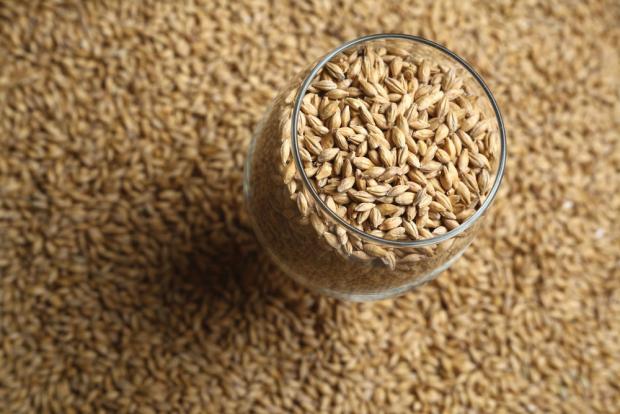Malt, the Soul of Beer
If every beer, as American Brewer’s Jack Curtain says, is now an IPA, it’s easy to forget that there’s more to beer than hops. Oh, sure there’s a lot to love about those beautiful bines, but they’re a relatively new addition to a brewmaster’s tool kit. (Evidence suggests that commercial hop cultivation began in northern Germany during the 12th or 13th century.) Instead, consider malt—born from the unassuming kernels of barley or wheat or rye—as the original rock star of brewers and beer drinkers alike.
What is malt? According to my Maltster’s Handbook, malt is a natural food product developed by germinating and then kilning cereal grains under carefully controlled conditions. But according to me, the maltster, malt—whether it’s whole, ground, powdered, or a liquid extract—is the nectar of the beer gods, and you couldn’t make beer without it. Malting developed around 6,000 years ago when ancient Mesopotamians recognized the beneficial changes in the texture and flavor of food prepared with accidentally germinated grains; they began brewing with it about 5,500 years ago.
Originally, all malting was small-scale. According to legend, early Egyptians manufactured malt by placing it in a wicker basket, which was then lowered into open wells. After steeping in the cool well water, it was raised above the water level for germination. The rate of germination was controlled by adjusting the height of the basket within the well. As germination progressed and heat developed, the basket would be lowered once again to obtain a lower temperature level, thus retarding growth and dissipating heat. To accelerate germination, the basket was simply raised to a higher level. The malt was kept from matting by raising it to the top of the well and agitating the basket. Drying was simple, it was spread on the ground, and subjected to the direct rays of the sun. That process remains virtually unchanged today.
So here we go. Malting 101—an overview:
Steeping
Steeping not only cleans the grain, it activates the resting embryo by providing water and oxygen to initiate germination—or chitting—and triggers synthesis of gibberellic acid (a hormone found in plants that promotes growth and the elongation of cells). Steeping enables barley to absorb sufficient water for germination and for hydration of the endosperm to facilitate modification during germination. Steeping also encourages hydrolytic enzymes to uniformly move throughout the endosperm. The entire process takes 36 to 48 hours.
Germination
Germination continues the physiological activity started in the steep. It permits the growth of the embryo under controlled conditions and develops hydrolytic enzymes while breaking down cell walls completely, and proteins and starches partially. During germination, temperatures are kept cool for 3.5 to 4.5 days. Ideal moisture level is maintained and grains are turned every eight to 10 hours to prevent matting.
Kilning
Kilning stops germination gradually by lowering the moisture of the green malt. Undesirable flavors are removed and appropriate aroma and color are allowed to develop. This 48-hour process preserves adequate enzymes while ensuring the integrity of the grain is kept in check. Kilning can be further broken down into three optimal phases: drying phase, curing phase, and a final cooling phase.
While base malts make up a substantial portion of the grain bill, specialty malts are used in smaller quantities to produce a unique profile of flavor, color, body, foam development,and foam stability. And the malting process varies slightly for each kind of speciality malt. Some malts are roasted after germination while others spend more time in the kiln or undergo a final roasting.
LOCAL MALT STARS
Hamburg Brewing Company, House Dressing (5% ABV): A hop forward American Amber Ale with New York State grown malt and hops. Available year round in the tap room and at select pubs.
Big Ditch Brewing Company, Cinnamon Apple Ale (6.8% ABV): Uses locally pressed cider from New York State apples, a portion of local barley, Niagara County hops, cinnamon & allspice. Taste of fall in spring. On tap at the brewery and in select pubs.
Flying Bison, New York State Barnstormer Pale Ale (4% ABV): Made with 100 percent New York State ingredients. Malts from New York Craft Malt. Hops from Wrobel Farms. On tap at the tap room and at select local pubs.
Resurgence Brewery, NYS Schwarzbier (4.6% ABV): Made with 100 percent New York State ingredients. Malts, including new roasted malt, from New York Craft Malt. Made special for Farm to Pint Event on May 17.
Resurgence Brewery, WNY Smash Beer (4.5% ABV): Made with 100 percent New York State ingredients. Smash = single malt, single hop. Malt from New York Craft Malt. Hops from High Bines in Niagara County.
Old First Ward Brewing Company, Therapy Session (4.6% ABV): Made with 100 percent New York State ingredients. Malts and hops from Niagara Malts in Niagara County. A very hop forward session pale ale that will set you right.
 The Public’s weekly beer column is a collaboration with the Buffalo Niagara Brewers Association.
The Public’s weekly beer column is a collaboration with the Buffalo Niagara Brewers Association.

